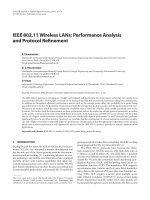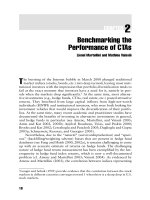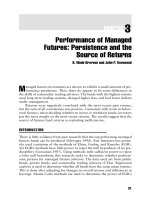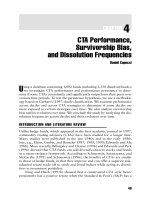Factors driving the 4g related service sales performance analysis and implication to the mobifone
Bạn đang xem bản rút gọn của tài liệu. Xem và tải ngay bản đầy đủ của tài liệu tại đây (1.93 MB, 72 trang )
Lunghwa University of Science and Technology
Department of Business Administration
Thesis for a Master’s Degree
Factors driving the 4G-related service
sales performance – Analysis and Implication to
the MobiFone
Researcher: DANG THI ANH DAO
Supervisor: Nguyen Phu Hung
May 2017
MINISTRY OF EDUCATION AND TRAINING
INTERNATIONAL SCHOOL – VNU
---------------
MASTER THESIS OUTLINE
Major: Business Administration
Branch code:EMBA
Factors driving the 4G-related service sales performance –
analysis and implication to the MobiFone
STUDENT:DANG THI ANH DAO
INSTRUCTOR: NGUYEN PHU HUNG
Hanoi,05/2017
Lunghwa University of Science and Technology
Approval Certificate of Master's Degree Examination Board
This is to certify that the Master’s Degree Examinations Board has
approved the thesis Factors driving the 4G-related service sales
performance - Analysis and Implication to the MobiFonepublished by
Ms.Dang Thi Anh Dao in the Master Program of Graduate School of
Department of Business Administration
Master’s Degree Examination Board
Board
Members:
Advisors:
Professor Fengi Hu
Doctor Nguyen Phu Hung
Chair:
Date:/ / 2017
ABSTRACT
Thesis Title:Factors driving the 4G-related service sales performance Analysis and
Implication to the MobiFonePages:58
University:Lunghwa University of Science and Technology
Graduate School:Department of Business Administration
Date:July, 2017
Degree:Master
Graduate Student:Dang Thi Anh Dao
Advisor: Dr. Nguyen Phu Hung
Keywords:Sales performance, telecommunication,
This thesis is dedicated to study factors driving sales performance of MobiFone’s 4Grelated services. The survey findings showa number of factors. The most impacting
factor is the capability of the mobile data should be improved to match with the need
of customers so that to attract more customers. Younger customers always have high
potential mobile data demand growthfor their social network interaction (e.g.,
facebook, tweeter), but slow network capability make them reluctant to pay.
Affordability is the second most important factor – as most of the hardware are
recently installed, the price tag to mobiledata customers are high but that in turn
driving down the demands, making the pay-back period longer, hiting the financial
sustainability of MobiFone. Among several implications of the findings, the most
important proposal is MobiFone should price different customer groups flexibly.
i
ACKNOWLEDGEMENT
It is a great pleasure for me to work with this dissertation. I would especially like to
thank all teachers, professors for all knowledge, skills and information I received. It is
very wonderful chance to work with so excellent and enthusiastic professors.
I am also very grateful to my tutor, Professor Nguyen Phu Hung, for his support. I
appreciate all his time and efforts to encourage and guide me during my dissertation
writing.
I would like to thank my colleagues, my customers for helping me to support me
information to complete this dissertation and answer the questionnaire for my research.
This thesis cannot be done without their help.
Finally, I would like to thank and dedicate this dissertation to my family for the
unconditional support, who consistency motivated me to complete the thesis.
Best regards,
Thank you!
Dang Thi Anh Dao
ii
TABLES OF CONTENTS
ABSTRACT ...................................................................................................................... i
ACKNOWLEDGEMENT............................................................................................... ii
TABLES OF CONTENTS ............................................................................................ iii
LIST OF TABLES ......................................................................................................... vi
LIST OF FIGURES........................................................................................................ vi
LIST OF ABBREVIATIONS ....................................................................................... vii
FOREWORDS ............................................................................................................. viii
CHAPTER 1 INTRODUCTION .................................................................................... 1
1.1
The rationale of the study topic of thesis................................................................... 1
1.2
Objectives of thesis .................................................................................................. 1
1.3
Objects and scope of thesis ....................................................................................... 2
1.4
Study questions ........................................................................................................ 2
1.5
Research Methodologies and Data ............................................................................ 2
1.5.1 Research process ........................................................................................... 2
1.5.2 Data .............................................................................................................. 3
1.5.3 Handling collected data................................................................................. 4
1.6
Plan of thesis ............................................................................................................ 4
CHAPTER 2 BACKGROUND OF THE MOBILE PHONE AND ITS CONTEXTS.. 5
2.1
Historical developments of MobileFone ................................................................... 5
2.2
Organizational structure ........................................................................................... 7
2.3
MobileFone Vision and Missions ........................................................................... 10
2.4
Development policy ............................................................................................... 11
2.5 Current status of the reorganizing, renovating and restructuring enterprise
program........................................................................................................................... 12
iii
2.6
SWOT Analysis of MobiFone performance ............................................................ 13
2.6.1 Threats ........................................................................................................ 13
2.6.2 Strength ...................................................................................................... 14
2.6.3 Weakness .................................................................................................... 15
2.6.4 Opportunities .............................................................................................. 15
2.7
Vietnam’sTelecommunications current status and future paths ............................... 17
2.7.1 History of broadband service in the Vietnam market ................................... 17
2.7.2 Structure of broadband in Vietnam .............................................................. 18
2.7.3 Emergence of 4G services ........................................................................... 20
2.7.4 Competition in the mobile market ............................................................... 21
2.8
Conclusion ............................................................................................................. 24
CHAPTER 3 LITERATURE REVIEWS .................................................................... 25
3.1
Overview of mobile data service and the 4G network ............................................. 25
3.1.1 History of mobile technology generations ................................................... 25
3.1.2 Outstanding features of the 4G network over previous generations .............. 27
3.2
Drivers of mobile service demands ......................................................................... 28
3.2.1 Demand-side drivers ................................................................................... 28
3.2.2 Supply-side drivers ..................................................................................... 32
3.3
Factors affecting sales in telecommunication industry ............................................ 35
3.4
International mobile market experiences ................................................................. 36
3.5
The future market of mobile data ............................................................................ 39
3.6
Conclusions ............................................................................................................ 41
CHAPTER 4 DATA ANALYSIS RESULTS ............................................................... 42
4.1
Introduction............................................................................................................ 42
4.2
Results of survey .................................................................................................... 42
4.2.1 The relevant of sample size ......................................................................... 42
4.2.2 How the affordability of 4G services influences customers' usage? ............. 42
4.2.3 How the pricing flexibility of service influence your 4G usage? .................. 43
4.2.4 Influence of the affordability of 4G capable mobile devices ........................ 43
4.2.5 Influence of Availability of 4G capable mobile devices............................... 44
4.2.6 Influence of the marketing campains ........................................................... 44
4.2.7 Influence of the Customer Relationship Management program.................... 44
4.2.8 Customer demands for high data rate applications(youtube, facebook
video, etc.) ............................................................................................................. 45
4.2.9 Influence of Competition in the 4G mobile data market .............................. 45
4.2.10 The status of the national and international economy .................................. 46
4.2.11 Influene of the Availability of Free Wi-Fi Access Points ............................. 46
iv
4.2.12 The influence of personal income to customers’ demands of 4G service ..... 47
4.3
Results of secondary data ....................................................................................... 47
CHAPTER 5 FINDING DISCUSSIONS AND IMPLICATION TO MOBIFONE .... 49
5.1
Summary of factors driving 4G market ................................................................... 49
5.2
Implications to MobiFone ...................................................................................... 49
5.2.1 Pricing Flexibility ....................................................................................... 49
5.2.2 The requirement to upgrade mobile data service to 4G ................................ 50
5.2.3 Working with CSPs and mobile app developers do to generate while
harness data growth ................................................................................................ 51
5.2.4 Targeting younger customer groups ............................................................ 51
5.2.5 Solutions on business, marketing ................................................................ 52
5.2.6 Measures of Technology ............................................................................. 52
5.2.7 Measure to improve management and operation performance ..................... 53
5.3
Conclusions ............................................................................................................ 54
LIST OF REFERENCES .............................................................................................. 57
APPENDIX .................................................................................................................... 59
Questionnaire ................................................................................................................ 59
v
LIST OF TABLES
Table 1. Total revenues of MobiFone (billions) ........................................................... 14
Table 2. 4G licenses in the Vietnam Market ................................................................ 20
Table 3. An example of flexible plan offered in the Latin American region ................. 32
LIST OF FIGURES
Figure 1. The study model of the thesis .........................................................................3
Figure 2. Organization of MobiFone ..............................................................................7
Figure 3. SWOT analysis on MobiFone ....................................................................... 16
Figure 4. Mobile technology evolution ........................................................................ 26
Figure 5. Structure of the 4-G network ........................................................................ 27
Figure 6. Annual global mobile data traffic (in Exabytes) ............................................ 39
Figure 7. How the affordability of 4G services influences customers' usage? ............... 42
Figure 8. Influence of pricing flexibility of service to 4G usage ................................... 43
Figure 9. Influence of the affordability of 4G capable mobile devices .......................... 43
Figure 10. Influence of Availability of 4G capable mobile devices .............................. 44
Figure 11. Influence of the marketing campains........................................................... 44
Figure 12. Influence of the Customer Relationship Management program ................... 45
Figure 13. Customer demands for high data rate applications ......................................45
Figure 14. Influence of Competition in the 4G mobile data market .............................. 46
Figure 15. The status of the national and international economy .................................. 46
Figure 16. Influene of the availability of Free Wi-Fi Access Points.............................. 47
Figure 17. The influence of personal income to customers’ demands of 4G service ..... 47
vi
LIST OF ABBREVIATIONS
MIC
Ministry of Information and Communication
MobiFone
Vietnam Mobile Telecom Services One Member Limited
Liability Company
Telecom
Telecommunication
VIETTEL
Viet nam Telecommunication corporation
VNPT
Vietnam Posts and Telecommunication Corporation
vii
FOREWORDS
Mobile data demand is growing fast year by year. Being one of the top leader of the
telecommunication industry, MobiFone cannot stay out of the competition.
Facing with tough competition from market, MobiFone has invest significantly to
every opportunities and technology to not only retain current customer and attract new
customers, but also to enlarge the usage of current customers. This thesis is dedicated to
find drivers of the mobile data demands so that the MobiFone company can focus its
resources to invest into the right drivers to increase the damands of customers, rather
than invest in every factors. This would help to improve the productivity of investment.
viii
CHAPTER 1
INTRODUCTION
1.1
The rationale of the study topic of thesis
Facing the strong growth trends of smartphone devices and mobile communication
networks 4G / LTE, the ways in which consumers use telecommunications services
including voice, data and other services haveprogressively changed. This impact
significantlybusiness activities of the mobile communication networks. 4G networks
with their many advantages over 3G ones will impact the behavior and habits of
customers. The proliferation of smart devices will bring about new business
opportunities for telecommunication service providers/operators, and this trend will also
include challenges if the service provider attempt to direct customers to alter their
habits.
To grasp this fact, the topic "Factors driving the 4G-related service sales
performance - analysis and implication to the MobiFone" aims to study the waysto
provide 4G servicesin the current MobiFone platform that responds to the requirements
of customers whose devices support 4G/LTE, under the anticipated assumptions on the
future development market trends.
1.2
Objectives of thesis
Analysing the current status of the system capacity, the deployment device's
MobiFone 4G network across the country, changing demands of customers;
Proposingcertain solutions to (i) put into operation the 4G Network in Vietnam
market, and (ii) improve its efficiency.
1
1.3
Objects and scope of thesis
The research object is the MobileFone’s the MobiFone 4G / LTE services
Regarding study scope, under the constraints in resources, data, and time, this thesis
just focuses on the following issues:
o Characteristics of the provision of 4G services in Hanoi markets;
o Factors driving the sales of 4G services;
o Mobile data market situation from 2012 to present.
1.4
Study questions
What are the business performance of the MobiFone? What are the strength,
weakness, challenges, and opportunities for MobiFone in time of hard competition?
Why 4G network is critical to the survival of MobiFone?
What is the status-quo of the mobile data market and its projected development?
How 4G service should be integrated into the provision of Mobifone to maintain
current customers and attract new customers?
1.5
How to improve performance of 4G sales?
Research Methodologies and Data
1.5.1 Research process
The picture below shows the study model of thesis.
2
Figure 1. The study model of the thesis
Building
Systematize database
requirements frame
and practice
and preliminary
The potential to
plans analysis
develop systems 4G
/ LTE MobiFone
Interview
The situation of
telecommunications
Investigation
network services
system without 4G /
Observation
Deployment process
LTE
analysis
1.5.2 Data
This thesis will get data from two sources, primary and secondary.
1.5.2.1 Primary data
Data can be collected via 3 ways:
In-depth interviews with customers to identify customer demands and customer
impressions on the quality of current 4G services;
Direct interview with internal employees to get overall picture on thematch of
current capacity with current and future requirements to serve 4G services;
Survey by questionnaire: Use a electronic form sent to a large number of targeted
customers to gather their assessment about the telecommunications network.
1.5.2.2 Secondary data
Reports published by the Government regulatory bodies, such as VNPT, MIC, etc;
Reports published by international organizations, such as World Bank and IMF, ITU
related to telecommunications networks and service outlooks in recent years and
future.
3
1.5.3 Handling collected data
Using statistical and synthesis methods, using SPSS software.
1.6
Plan of thesis
Date
Tasks
1/2017
Proposal submission
2/2017
Tutor comments proposal
4/2017
First Draft of thesis
5/2017
Second Draft of thesis
6/2017
Turn in final thesis
8/2017
Thesis defense
4
CHAPTER 2
BACKGROUND OF THE MOBIFONE
2.1
Historical developments of MobileFone
MobiFone Corporation is one of the top 2 telecommunication service provider in
Vietnam. MobiFone locates at Lot VP1, Yen Hoa Ward, Cau Giay District, Hanoi.
MobiFone has come a long way since 1993, when we are the first mobile network
operator in Vietnam. Today, it is our pleasure to be the communication way of nearly 50
million subscribers (about 30% of market share). In 2014, MobiFone Corporation’s
revenue exceeded 2 billion dollars, which let us remain one of the three largest mobile
operators in Vietnam(MobiFone, 2017).
Since its establishment, quality plays as a key strategy to all MobiFone leaders. We
are honored to be awarded “The most favorite mobile operator” 6 years-in-a-row, which
means MobiFone is trusted by customers.
Communicate is vital to all of us. Hence, MobiFone Corporation now provides a
diverse range of services including mobile, data, internet, IPTV/cable TV, business
solutions, infocomm technology (ICT), and investment. We understand, in an
increasingly connected world, it’s no longer just about being able to talk and text. With
our network, you can capture and share your feelings as soon as they created.
1993: Vietnam Mobile Telecom Services Company (VMS) was formed. Director
Mr. Đinh Văn Phước
1994: Vietnam Mobile Telecom Services Centers I and II were formed (in the
North and South)
5
1995: VMS entered into the Business Cooperation Contract (BCC) with Swedish
Kinnevik/Comvik. Vietnam Mobile Telecom Services Center III was formed (in the
Central region of Vietnam)
2005: The BBC between VMS and Swedish Kinnevik/Comvik came to the end.
Vietnam Ministry of Posts and Telecommunications (now called Vietnam Ministry of
Information and Communications) finalized the decision on the equitization of VMS.
Mr. Le Ngoc Minh took the office after former Director Dinh Van Phuoc stepped down
for retirement.
2006: Vietnam Mobile Telecom Services Center IV was formed
2008: Vietnam Mobile Telecom Services Center V was formed. VMS celebrated
15th anniversary of establishment.
Value Added Services Center was formed
April 2008, MobiFone has been the first market share holder on Vietnam’s telecom
market.
2009: VMS received the Excellent Operator Prize 2008 awarded by Vietnam
Ministry of Information and Communications. VMS-MobiFone officially launches 3G
services; The Business Support Center was formed.
7/2010: VMS was transformed into the One member liability State company.
2013: VMS celebrated 20th anniversary of celebration and receives 3rd Rank of
Independence Medal.
2014:26/06: Mr. Mai Van Binh was appointed Chairman of VMS MobiFone.
10/07: Handing over the right to represent the owner of the State in VMS
MobiFone from VNPT to MIC.
13/08: Mr. Le Nam Tra was appointed General Director of VMS MobiFone. 01/12:
MobiFone Corporation was established based on the reorganization of Vietnam Mobile
Telecom Services One Member Limited Liability Company.
6
2015:21/04: Mr. Le Nam Tra was appointed Chairman of the Board Members
MobiFone Corporation. Mr. Cao Duy Hai was appointed General Director of MobiFone
Corporation.
2.2
Organizational structure
MobiFone Corporation includes 20 functional departments and 20 under units
including 09 MobiFone services companies, International Telecom Center, Network
Operator Center (NOC), Multimedia – Value Added Services Center, MobiFone IT
Center, Northern/Central/Southern MobiFone network, Testing and Maintenance
Center, Billing and Services Support Center, Research and Development Center,
Consultation – Design Center.
Also, MobiFone has three subsidiaries: MobiFone Services, JSC., MobiFone
Global, JSC. and MobiFone Plus, JSC.
Figure 2. Organization of MobiFone
MobiFone
Corporation
20 functional
departments
20 Units
9 MobiFone
services
companies
Subsidiaries
8 Centers
MobiFone service company region 1 is headquartered in Hanoi, responsible for
deliver services to all customers in Hanoi, comply with the development plan of
corporation.
Add: MobiFone Building – Duy Tan. 5/82 Duy Tan Street, Cau Giay District,
Hanoi.
7
MobiFone service company region 2 is headquartered in Hochiminh City,
responsible for deliver services to all customers in Hochiminh City, comply with the
development plan of corporation.
Add: MM 18, Truong Son Street, Ward 14, District 10, HCM City.
MobiFone service company region 3 is headquartered in Danang City, responsible
for deliver services to all customers in Central Region: Danang, Quang Tri, Thua Thien
Hue, Quang Nam, Quang Ngai, Binh Dinh and Phu Yen, comply with the development
plan of corporation.
Add: 391 Nguyen Van Linh Street, Danang City.
MobiFone service company region 4 is headquartered in Vinh Phuc, responsible
for deliver services to all customers in: Lao Cai, Lai Chau, Dien Bien, Yen Bai, Son La,
Phu Tho, Hoa Binh, Ha Nam, Nam Dinh, Ninh Binh and Vinh Phuc, comply with the
development plan of corporation.
Add: 414 Me Linh Street, Khai Quang Ward, Vinh Yen City, Vinh Phuc.
MobiFone service company region 5 is headquartered in Hai Phong City,
responsible for deliver services to all customers in: Hai Phong, Quang Ninh, Hai
Duong, Thai Binh, Hung Yen, Bac Ninh, Bac Giang, Lang Son, Thai Nguyen, Bac Can,
Tuyen Quang, Cao Bang and Ha Giang, comply with the development plan of
corporation.
Add: No. 8, Lot 28A, Le Hong Phong, Ngo Quyen District, Hai Phong City.
MobiFone service company region 6 is headquartered in Nghe An, responsible for
deliver services to all customers in: Thanh Hoa, Nghe An, Ha Tinh and Quang Binh,
comply with the development plan of corporation.
Add: 10 Nguyen Thi Minh Khai Street, Hung Binh Ward, Vinh City, Nghe An.
MobiFone service company region 7 is headquartered in Khanh Hoa, responsible
for deliver services to all customers in: Kon Tum, Gia Lai, Dac Lac, Dac Nong and
Khanh Hoa, comply with the development plan of corporation.
8
Add: 21 Hai Ba Trung Street, Huong Xuan Ward, Nha Trang City, Khanh Hoa.
MobiFone service company region 8 is headquartered in Dong Nai, responsible for
deliver services to all customers in: Dong Nai, Lam Dong, Ninh Thuan, Binh Thuan,
Binh Phuoc, Binh Duong, Tay Ninh, Ba Ria – Vung Tau and Long An, comply with the
development plan of corporation.
Add: 22/8 Nguyen Ai Quoc Street, Quang Vinh Ward, Bien Hoa City, Dong Nai.
MobiFone service company region 9 is headquartered in Can Tho, responsible for
deliver services to all customers in: Can Tho, Tien Giang, Ben Tre, Vinh Long, Tra
Vinh, Dong Thap, An Giang, Hau Giang, Soc Trang, Bac Lieu, Ca Mau and Kien
Giang, comply with the development plan of corporation.
Add: 06 Hoa Binh Street, Ninh Kieu, Can Tho.
MobiFone International Telecomunications Center specializes in managing and
doing business in international telecommunications and roaming services; researching
solutions, devices and applications to develop international telecommunications
services; routing international traffic; maintaining the quality of international
telecommunication services.
Network Operator Center (NOC) specializes in managing, operating and
maintaining
equipment,
transmission
and
infrastructure
of
core
network;
Troubleshooting core network; Ensuring the quality of traffic directions and services
delivering to customers; Coordinating other departments in development of network,
deploy new services, safety and security.
MobiFone Research and Development Center specializes in researching and
applying the results to develop new technological solutions at the Corporation;
Designing new products and services, including telecommunication services, valueadded services, IT services…; Researching to improve quality and optimise cost of
products and services; Organizing research and deployment of technology which have
been delivered; Co-operating with partners working on technology; Consulting on
technology transfer, intellectual property rights; Consulting on technology, products and
services to MobiFone Corporation and units.
9
MobiFone Multimedia – Value Added Services Center specializes in implementing
business plans, business policy, developing products and value-added service, data; Cooperating with partners which provide content…
MobiFone IT Center specializes in researching and developing new software for IT
service units in the Corporations, as well as customers outside; Managing system’s
software which is implementing by partners, technology transfer, upgrading and
expanding the feature of system; Researching, updating and testing new technology;
proposing plans to apply new technology; providing new software services; System
integration, technical support, maintenance, training… to customers.
MobiFone Testing and Maintenance Center specializes in installing and fixing
telecommunications equipment and components; Testing network quality; Providing
data optimization of the units in Corporation; Researching, testing technology
solutions…
MobiFone Billing and Services Support Center specializes in extracting billing
systems of internal Corporation’s IT, as well as support network technical and provide
data for the business activities of the Corporation.
MobiFone Consultation – Design Center specializes in consulting investment in
constructing mobile communication, information and telecommunications for units
inside and outside the Corporation.
Northern/Central/Southern MobiFone network specializes in managing, operating
and maintaining equipment, transmission and infrastructure of networks components;
Troubleshooting of broadcast station; Ensuring the quality of network in the area; Cooperating in the development of network, deploying new services and flood prevention.
2.3
MobileFone Vision and Missions
MobiFone attempts to put a highlighted mark in this great era to sharp significant
values of happiness for a future. In 2015-2020, our vision is obviously expressed in the
Declaration: Connecting values, evoking potentials. This vision reflects the commitment
of MobiFone towards the comprehensive and sustainable development based on
10
relationships between the three pillars: customers, partners, and every single employee.
We are to become the most beloved telecommunication brand in Vietnam and achieve
revenue of $5 billion by 2020.
MobileFone believes its mission is to bring its products and services that will be
able to connect all people in one ecosystem where the demands of life, work, study and
entertainment are detected, waken up and satisfied to achieve development and
happiness. The development in cognition, relationships and business opportunities and
the happiness will be achieved by kindly care and encouragement. Growth and
happiness are driving forces for the development of both individual and society.
MobiFone has identified four key “pillars” of its growth strategy in the coming
time, including (i) Mobile, (ii) TV, (iii) Retail, and (iv) Multi-service. The message
given to customers is "Connecting Value, Raising Potential" and the business guideline
is "Consulting - Training - Communication - Link - Segment - Resonance". MobiFone's
4G / LTE services are therefore based also on the pillars and business motto of
MobiFone.
However, the deployment of new services are facing many difficulties and
challenges, can be seen in the following SWOT of MobiFone
2.4
Development policy
Development
investment
projects
of the
MobiFone
Telecommunications
Corporation are accelerating. Major projects focus on the development of network
infrastructure, broadcasting 3G stations with the aim of getting data business as the
focus, enhancing quality and coverage.
Apart from traditional investment programs, MobiFone has initially expanded into
new investment programs such as transmission and information technology systems for
production and business. In 2015, the MobiFone Corporation has completed 82/278
projects (7 Group B projects and 75 Group C projects). The total capital disburssement
is about VND 2,448 billion. The total value of additional assets put into business lines
reach about 3,177 billion.
11
In addition, the Corporation continues to accelerate investment, construction of
architectural works(MobiFone, 2016; MobiFone, 2015).
2.5
Current status of the reorganizing, renovating and restructuring
enterprise program
MobiFone is under governmental control from the Ministry of Information and
Communication Technology (MIC). MIC has directed MobiFone to restructure to adapt
with the new market and legislative environment.
Implementing Decision No. 1798 / QD-BTTTT dated 1 st December 2014 by the
Ministry of Information and Communications that requires to establish MobiFone
Telecom Corporation, as well as the directive given in the Official Letter No. 663 /
BTTTT dated March 13, 2015, a new corporation was created on the basis of the
reorganization of then incumbent Mobile Communication One Member Limited
Liability Company.
The new MobiFone now has three division. The first division includes back-offices,
consisting of 20 units and offices. Thesecond division include 20 subordinate units.
There are 3 subsidiary companies.
MobiFone has appointed the key leaders for all units, run program to improve the
personnel qualification.
In 2015, MobiFone cooperated with the third-party consultancy firm to implement
the valuation process on MobiFone. All major results of enterprise valuation were
submitted to the Steering Committee of the Corporatization Program as well as to the
Ministry of Information and Communications. The MobiFone also submitted an draft of
the Equitisation Plan(MobiFone, 2015).
12
2.6
SWOT Analysis of MobiFone performance
2.6.1 Threats
In 2015, the competition in the telecom market is fierce. MobiFone's telecom, as
well as other telecom companies, is facing variety of challenges from external factors.
First, the competition from competitors are growing: customers now are having
many choices to select from and to switch to, thus the customer base become less stable.
Second, the competition from substitute products are growing: OTT applications
make traditional and basic telecom service sales revenue decline quickly; Public wifi
reduces need of telecom communication services.
Third, growing demands from customers require MobineFone to keep enhancing its
service provisions and introducing new products, Value-Added services.
Forth, shifting customers’ demands are making MobiFone to change its system,
mofifying offers to customers. Currently, the structure of MobiFone's services still
focuses on SMS and 3G mobile internet services, with low quality and almost no special
content licensing.
Fifth, GSMA Intelligence notes that users may change to Wi-Fi networks since
most of them are provided free in the Vietnam Market.
These threats directly affecting the profitability of MobiFone.
The Annual Report of MobiFone (MobiFone, 2016) lists the following threats:
•
Government over-regulatory policy
•
Free OTT provisions taking away potential revenues for MobiFone
•
Strong competition from other mobile service providers
13
2.6.2 Strength
Overcoming many obstacles and challenges in 2015, MobiFone continues to focus
on developing its core business of telecommunications to ensure stable revenue and
profit targets.
MobiFone has completed its restructuring programme in 2014. MobiFone has
transformed into a new organizational structure, a group corporation, to stabilize its
operations and production systems.
The business indicators show performance in well in excess of the MIC plan
expectation:
- Consolidated revenue: reached VND 33,553 billion, completing 105.6% of the
plan.
- Consolidated profit before tax was VND 7,199 billion.
Table 1. Total revenues of MobiFone (billions)
Contents
2012
2013
2014
2015
Consolidated revenue
41.368
39.494
36.258
33,553
Consolidated profit before tax
6.709
7.200
7.483
7,199
(Source: MobiFone, 2016)
Annual report of MobiFone (MobiFone, 2016) provides the following strength:
•
MobiFone is a top brand
•
Good working environment
•
Multiple service provision
•
Social policy
•
Large customer-base
14









